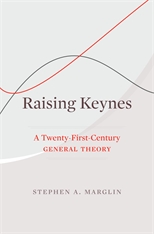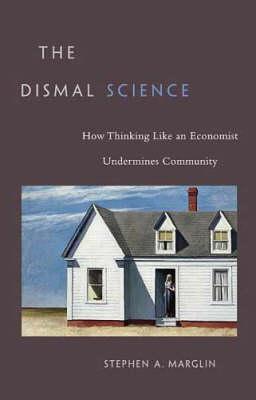Raising Keynes
a twenty-first-century general theory
- ISBN: 9780674971028
- Editorial: Harvard University Press
- Fecha de la edición: 2021
- Lugar de la edición: Cambridge (Mass). Estados Unidos de Norteamérica
- Encuadernación: Cartoné
- Medidas: 24 cm
- Nº Pág.: 896
- Idiomas: Inglés

Back to the future: a heterodox economist rewrites Keynes’s General Theory of Employment, Interest, and Money to serve as the basis for a macroeconomics for the twenty-first century.
John Maynard Keynes’s General Theory of Employment, Interest, and Money was the most influential economic idea of the twentieth century. But, argues Stephen Marglin, its radical implications were obscured by Keynes’s lack of the mathematical tools necessary to argue convincingly that the problem was the market itself, as distinct from myriad sources of friction around its margins.
Marglin fills in the theoretical gaps, revealing the deeper meaning of the General Theory. Drawing on eight decades of discussion and debate since the General Theory was published, as well as on his own research, Marglin substantiates Keynes’s intuition that there is no mechanism within a capitalist economy that ensures full employment. Even if deregulating the economy could make it more like the textbook ideal of perfect competition, this would not address the problem that Keynes identified: the potential inadequacy of aggregate demand.
Ordinary citizens have paid a steep price for the distortion of Keynes’s message. Fiscal policy has been relegated to emergencies like the Great Recession. Monetary policy has focused unduly on inflation. In both cases the underlying rationale is the false premise that in the long run at least the economy is self-regulating so that fiscal policy is unnecessary and inflation beyond a modest two percent serves no useful purpose.
Fleshing out Keynes’s intuition that the problem is not the warts on the body of capitalism but capitalism itself, Raising Keynes provides the foundation for a twenty-first-century macroeconomics that can both respond to crises and guide long-run policy.
Notation
Prologue: What Is This Book About?
I. Background: The Rise and Fall
1. Introduction: Is This Resurrection Necessary?
2. What Were They Thinking? Economics before The General Theory
II. Keynes Defeated: Static Models and the Critics
3. The Determination of Output and Employment: First and Second Passes at Equilibrium
Appendix 1: Keynes’s Definition(s) of Unemployment
Appendix 2: Do Interest Rates Adjust Saving and Investment?
Mathematical Appendix
4. Equilibrium with a Given Money Supply: Critical Perspectives on the Second-Pass Model
Mathematical Appendix
III. Keynes Vindicated: A Theory of Real-Time Changes
5. The Price Mechanism: Gospels According to Marshall and Walras
Mathematical Appendix
6. The General Theory without Rigid Prices and Wages
Appendix: A Brief History of Stationary Real-Price Equilibria
Mathematical Appendix
7. Dynamics vs. Statics: Can the Economy Get from the Here of Unemployment to the There of Full Employment?
Mathematical Appendix
8. A Dose of Reality: The Evidence of the Great Depression
Appendix: Milton Friedman and Anna Schwartz on What Made the Depression Great
Mathematical Appendix
IV. Building Blocks
9. Consumption and Saving
Mathematical Appendix
10. Investment
Mathematical Appendix
11. The Theory of Interest, I: Liquidity Preference in a World of Money and Bonds
Appendix: Bond Coupons as Insurance against Price Declines
Mathematical Appendix
12. The Theory of Interest, II: Liquidity Preference as a Theory of Spreads
Mathematical Appendix
Empirical Appendix: What Do the Data Say?
13. Taking Money Seriously
Mathematical Appendix
V. Fiscal Policy in Theory and Practice
14. Functional Finance and the Stabilization of Aggregate Demand
15. Did the Obama Stimulus Work?
Empirical Appendix: Regressions and Their Discontents
16. Functional Finance and the Composition of Aggregate Demand
Appendix 1: Sound Finance as Starving the Beast
Appendix 2: The Empirics of Debt Sustainability
Appendix 3: Are Government Bonds Private Wealth? And What Difference Does It Make for the Sustainability of the Debt?
Mathematical Appendix
VI. Keynes in the Long Run
17. First Steps into the Long Run: Harrod, Domar, Solow, and Robinson
Appendix: Inventory Accumulation as a Brake on Output
18. Keynes in the Long Run: A Theory of Wages, Prices, and Employment
Mathematical Appendix
19. Inflation and Employment Empirics in the Keynesian Long Run
Epilogue: Attack Them in Their Citadel
Notes
References
Acknowledgments
Index








